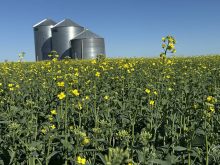U.S. rules fed market
Fed cattle average prices gained 50 cents per hundredweight last week, said Canfax.
Feedlots were reluctant sellers because they thought the weakening Canadian dollar would provide more price strength than it did.
Over the week, 19,000 head traded, down 14 percent from the week before.
U.S. buying ruled the Canadian market, setting the pace for bids. About 18,000 head moved south.
Alberta prices March 24 were steers $86-$87.75 per cwt., flat rail $145.50 and heifers $85.50-$88.25.
Many feedlots are cleaning up the last of their yearlings and are not ready to move their calves, said Canfax, adding the market will likely be steady for a week or two.
Read Also

Huge Black Sea flax crop to provide stiff competition
Russia and Kazakhstan harvested huge flax crops and will be providing stiff competition in China and the EU.
A rally in the cutout would be necessary to perk cash cattle up and that appears unlikely, said Canfax.
Beef demand slow
Canadian beef movement was sluggish. Kills have been small for the first quarter, but the market has struggled to move its inventory in spite of sideways to lower cut-out values. Cutouts at mid March were $3 lower on AA product and steady to 50 cents higher on AAA product.
The United States cutout last week lost $3 US on Choice and $2.25 on Select as the larger kill from the week before pressured prices lower. The Calgary wholesale market for product delivered this week is down $2 Cdn with handyweight steers quoted at $145-$148.
Last week’s Canadian kill was expected to be even smaller than the previous week’s 67,500 head because one large plant was closed March 22.
Quality feeders OK
Feeder cattle prices were weak early, but rose later in the week. Prices reflect quality with clean cattle selling higher and fleshy, taggy cattle discounted.
Feeder cattle exports reached a high for this year at 13,400 head for the week of March 18.
The much-needed moisture that fell in parts of Alberta will support grass cattle prices.
Light heifers 300-500 lb. decreased 75 cents-$1, heifers 500-700 lb. rose 25 cents-$1.50, 700-900 lb. also rose 25-75 cents. Heifers 900 lb. and heavier fell $1.75.
Light steers 300-500 lb. were down $3-$4 per cwt., steers 500-600 lb. rose 50 cents, while 600-700 lb. steers were down 50 cents. Heavier steers 700-900 lb. and heavier rose 75 cents-$1.
While averages showed only slight gains, top-end prices were as much as $5-$7 higher, said Canfax.
Year-to-date Alberta auction market volume is up 19 percent over last year.
But the week’s volume was down 18 percent from the same week last year with 39,295 head reported sold.
D1, 2 cows rose 75 cents to average $38.81. Butcher bulls gained $2 to average $35.59.
Feeder prices might rise into April. Light cattle will be less dependent on the trends in the fed market but look for heavy feeders to respond to changes in fed cattle prices and forecasts into the summer and fall, said Canfax.
Feeder volumes are expected to remain fairly large over the next few weeks.
Stock bred cows were lower with most sales at $850-$1,350 and plain types $500-$800. Bred heifers in northern Alberta were higher at $900-$1,400 and plain types $625-$850. Cow-calf pairs were $950-$1,450 with plain types $650-$900.
Storm delays marketing
The snowstorm that hit the central plains last week slowed U.S. hog deliveries and slaughter, causing a backup in marketings.
Large poultry supplies also weighed on the market.
The composite pork carcass cut-out value slipped below $59 US midweek, but recovered to $61.21 US March 24, down from $61.25 March 17.
The Iowa-southern Minnesota live cash price for hogs delivered to plants fell to $41.50 per cwt. March 24, down from $42 March 17.
Federal slaughter in the U.S. was estimated at 1.95 million last week, down from 2.01 million the week before.
The U.S. Department of Agriculture said February pork production was record high for the month.
Analysts expect market-ready hog numbers will rise in coming weeks.
Sheep steady
Ontario Stockyards reported 1,381 sheep and lambs and 151 goats traded last week. All classes of sheep, lambs and goats sold at steady prices.
















